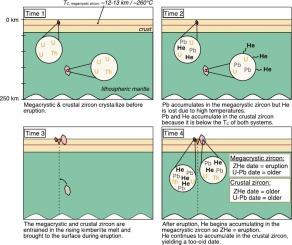配对巨晶锆石(U- th)/He和U/Pb定年揭示了金伯利岩喷发年龄、侵位史和巨晶成因
IF 3.6
2区 地球科学
Q1 GEOCHEMISTRY & GEOPHYSICS
引用次数: 0
摘要
在金伯利岩的上升和喷发期间,岩石圈中发生的过程的时间一直难以确定。在这里,我们提出了一种新的(U- th)/He和U/Pb配对年代学在巨晶锆石上的应用,以确定巨晶套的结晶和寄主金伯利岩喷发的年代。与Pb不同,He在250°C时不保留在晶体中。对于在地幔中结晶的巨晶锆石,He保留始于金伯利岩喷发,因此锆石(U-Th)/He(喆)日期应记录金伯利岩侵位。本文收集了加拿大Diavik和Panda、巴西Juína和Batovi-9、南非修道院(Monastery) 5种金伯利岩中9种巨晶锆石的阴极发光、微量元素、U/Pb和(U- th)/He数据。除Diavik锆石外,其余锆石的he和U/Pb测年在不确定范围内重叠,表明巨晶在金伯利岩喷发期间或喷发前不久结晶,表明金伯利岩岩浆与巨晶套之间存在遗传联系。对于Diavik锆石,喆年代比U/Pb年代年轻~ 2.5 Gyr,说明巨晶岩与寄主金伯利岩岩浆在遗传上不相关。哲的年龄来自三个金伯利岩,与其他方法解释的喷发年龄重叠。然而,对于Panda和Monastery,我们配对的zheu /Pb日期与之前的结果不同,与超过5 Myr的多次喷发一致,这意味着延长的喷发阶段可能比以前认为的更常见。我们的工作表明,巨晶锆石的(U- th)/He定年可以准确地确定金伯利岩的侵位,当与U/Pb定年相结合时,可以深入了解巨晶与金伯利岩的关系。本文章由计算机程序翻译,如有差异,请以英文原文为准。

Paired megacrystic zircon (U-Th)/He and U/Pb dating reveals kimberlite eruption ages, protracted emplacement histories, and insights into megacryst genesis
The timing of the processes occurring in the lithosphere during the ascent and eruption of kimberlites has been challenging to ascertain. Here, we present a novel application of paired (U-Th)/He and U/Pb geochronology on megacrystic zircon to date both the crystallization of the megacryst suite and the host kimberlite eruption. Unlike Pb, He is not retained in the crystal at temperatures >250 °C. For megacrystic zircon that crystallizes in the mantle, He retention begins upon kimberlite eruption such that the zircon (U-Th)/He (ZHe) dates should record kimberlite emplacement. We collected cathodoluminescence, trace element, U/Pb, and (U-Th)/He data for nine megacrystic zircon from five kimberlites: Diavik and Panda (Canada), Juína and Batovi-9 (Brazil), and Monastery (South Africa). For all zircon except from Diavik, ZHe and U/Pb dates overlap within uncertainty, indicating megacryst crystallization during or shortly before kimberlite eruption, and suggesting a genetic link between the kimberlite magma and megacryst suite. For Diavik zircon, the ZHe dates are ∼2.5 Gyr younger than the U/Pb dates, documenting that the megacrysts and the host kimberlite magma are genetically unrelated. ZHe dates from three of the kimberlites overlap with eruption ages interpreted from other methods. However, for Panda and Monastery, our paired ZHe-U/Pb dates differ from previous results, consistent with multiple eruptions over ∼5 Myr and implying that protracted eruptive phases may be more common than previously thought. Our work shows that (U-Th)/He dating of megacrystic zircon accurately dates kimberlite emplacement, and when coupled with U/Pb dating can yield insights into megacryst-kimberlite relationships.
求助全文
通过发布文献求助,成功后即可免费获取论文全文。
去求助
来源期刊

Chemical Geology
地学-地球化学与地球物理
CiteScore
7.20
自引率
10.30%
发文量
374
审稿时长
3.6 months
期刊介绍:
Chemical Geology is an international journal that publishes original research papers on isotopic and elemental geochemistry, geochronology and cosmochemistry.
The Journal focuses on chemical processes in igneous, metamorphic, and sedimentary petrology, low- and high-temperature aqueous solutions, biogeochemistry, the environment and cosmochemistry.
Papers that are field, experimentally, or computationally based are appropriate if they are of broad international interest. The Journal generally does not publish papers that are primarily of regional or local interest, or which are primarily focused on remediation and applied geochemistry.
The Journal also welcomes innovative papers dealing with significant analytical advances that are of wide interest in the community and extend significantly beyond the scope of what would be included in the methods section of a standard research paper.
 求助内容:
求助内容: 应助结果提醒方式:
应助结果提醒方式:


